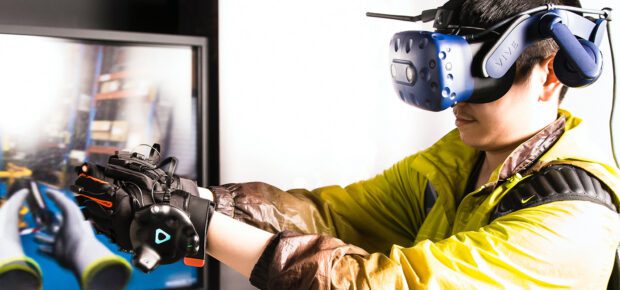October 4, 2022
When people put on a virtual reality (VR) headset, they’re transported.
But the VR experience is limited to sight and sound. And that can be limiting, especially for people with disabilities.
IEEE Member Anderson Maciel is working to remove those limits by making VR even more immersive. The key? Adding more senses – a sense of touch, and of smell.
“There’s no reason for a person with an amputated limb or a visual impairment to experience more barriers in VR than in the physical world,” Maciel said.
And in doing so, VR could also present new opportunities to teach people who do not have disabilities what it is like to live with one.
His research includes the development of a vibrotactile head-mounted display (HMD). Essentially, it is a VR headset that, instead of providing visual information to the user, is equipped with a set of vibrating motors arranged around the head. The motors vibrate, and that stimuli can be used to direct users when walking down the street.
“The idea was to offer the possibility to communicate directions to users without the need to see signs or gestures and leaving the auditory channel free for talking and environmental noise. The vibration motors can be placed in different configurations. We provided an efficient one, able to indicate a direction around the head and an elevation.”
Q: What interested you in applying the tools of virtual reality to help people with disabilities?
Accessibility and inclusiveness are always a goal in human-computer interaction. With VR, there are two sides. One the one hand, living in the body of another allows us to experience what it is like to have a missing limb, or to have a visual impairment. That’s a powerful and unique tool to engender empathy.
The work we do is not just about permanent blindness. It could be applied to situations in which a person might not be able to use their sense of vision, for example of a firefighter in a smoky building, or a miner in a dark cave. They are unable to see and must rely on other senses and knowledge to navigate and accomplish their mission.
Q: Do you think the blind or visually impaired might be able to fully participate in the metaverse?
The world is becoming more and more available for blind individuals, but there is a long way yet for total accessibility. Fortunately, technology is helping a lot. But another important aspect is that people in general need to be educated to understand the differences and difficulties of any impairment. I think VR and the metaverse will help on both sides, especially because it is easier to implement sensory substitution in the virtual world than in the real one.
Q: What have haptics taught you about human perception, about how we feel and sense?
Computer hapticss have been studied for decades. We’ve learned that hairy and hairless skin feel vibrations differently, even when hair is removed, that the perceptual resolution of skin varies from the body midline. Perceptual resolution of skin is heterogeneous in terms of vertical and horizontal variation, and that stretching the skin in specific areas changes the weight perception and the sense of direction.
The goal of VR is to provide full immersion, i.e. block all five senses and replace them with computer-generated stimuli.
In multimodal interaction with sighted individuals, we’ve used sound and vibrotactile notifications to point the eyes. We’ve noticed that the more senses we add to the experience, the more people are able to feel them.
Q: What are some of the ways you can use haptics to convey information?
Vibration patterns applied on different body locations can convey iconic information, such as what direction a person should go in, or the presence of obstacles. It can also convey more abstract information, such as yes or no. We’ve investigated whether people are capable of articulating haptic words or sentences, for example, “give me the object to your right”.
Q: VR is primarily an audio-visual medium. What other sensory experiences are on the horizon in VR?
Displays that convey smells or temperature have been available for some time, and they are making immersive environments richer.
I’d say olfactory systems have been successful in improving presence and we may see some applications in the near future.
Peltier-type thermoelectric generators are small enough and cheap enough to be integrated in wearables. I have tried some experiences where I could recognize some virtual objects were colder and some were hotter. But the actuators are slow. Users need to wait several seconds before the temperature change is perceived. So, the hardware technology is not perfected for VR yet.
Q: How might the hardware you are using now be used in the metaverse?
The metaverse is a huge opportunity for anyone developing interactive hardware and software for user experience, and this includes haptics. We believe that the fact that the haptic actuators are easily integrated into HMDs and controllers means that they have an important role on how people experience the metaverse. The possibilities are unlimited.
Learn more: IEEE members are on the front line of a rapidly developing metaverse, dealing with a wide range of questions that includes ethical and accessible design of virtual environments and the interoperability of VR equipment. If you’d like to join a global community of experts discussing these issues, check out the IEEE Standards Association’s Metaverse Congress.






 The Impact of Technology in 2025
The Impact of Technology in 2025 Quantum and AI: Safeguards or Threats to Cybersecurity?
Quantum and AI: Safeguards or Threats to Cybersecurity? Why AI Can't Live Without Us
Why AI Can't Live Without Us Bits, Bytes, Buildings and Bridges: Digital-Driven Infrastructure
Bits, Bytes, Buildings and Bridges: Digital-Driven Infrastructure Impact of Technology in 2024
Impact of Technology in 2024 Emerging AI Cybersecurity Challenges and Solutions
Emerging AI Cybersecurity Challenges and Solutions The Skies are Unlimited
The Skies are Unlimited Smart Cities 2030: How Tech is Reshaping Urbanscapes
Smart Cities 2030: How Tech is Reshaping Urbanscapes Impact of Technology 2023
Impact of Technology 2023 Cybersecurity for Life-Changing Innovations
Cybersecurity for Life-Changing Innovations Smarter Wearables Healthier Life
Smarter Wearables Healthier Life Infrastructure In Motion
Infrastructure In Motion The Impact of Tech in 2022 and Beyond
The Impact of Tech in 2022 and Beyond Cybersecurity, Technology and Protecting Our World
Cybersecurity, Technology and Protecting Our World How Technology Helps us Understand Our Health and Wellness
How Technology Helps us Understand Our Health and Wellness The Resilience of Humanity
The Resilience of Humanity Harnessing and Sustaining our Natural Resources
Harnessing and Sustaining our Natural Resources Creating Healthy Spaces Through Technology
Creating Healthy Spaces Through Technology Exceptional Infrastructure Challenges, Technology and Humanity
Exceptional Infrastructure Challenges, Technology and Humanity The Global Impact of IEEE's 802 Standards
The Global Impact of IEEE's 802 Standards Scenes of our Cyber Lives: The Security Threats and Technology Solutions Protecting Us
Scenes of our Cyber Lives: The Security Threats and Technology Solutions Protecting Us How Millennial Parents are Embracing Health and Wellness Technologies for Their Generation Alpha Kids
How Millennial Parents are Embracing Health and Wellness Technologies for Their Generation Alpha Kids Space Exploration, Technology and Our Lives
Space Exploration, Technology and Our Lives Global Innovation and the Environment
Global Innovation and the Environment How Technology, Privacy and Security are Changing Each Other (And Us)
How Technology, Privacy and Security are Changing Each Other (And Us) Find us in booth 31506, LVCC South Hall 3 and experience the Technology Moon Walk
Find us in booth 31506, LVCC South Hall 3 and experience the Technology Moon Walk Virtual and Mixed Reality
Virtual and Mixed Reality How Robots are Improving our Health
How Robots are Improving our Health IEEE Experts and the Robots They are Teaching
IEEE Experts and the Robots They are Teaching See how millennial parents around the world see AI impacting the lives of their tech-infused offspring
See how millennial parents around the world see AI impacting the lives of their tech-infused offspring Take the journey from farm to table and learn how IoT will help us reach the rising demand for food production
Take the journey from farm to table and learn how IoT will help us reach the rising demand for food production Watch technical experts discuss the latest cyber threats
Watch technical experts discuss the latest cyber threats Explore how researchers, teachers, explorers, healthcare and medical professionals use immersive technologies
Explore how researchers, teachers, explorers, healthcare and medical professionals use immersive technologies Follow the timeline to see how Generation AI will be impacted by technology
Follow the timeline to see how Generation AI will be impacted by technology Learn how your IoT data can be used by experiencing a day in a connected life
Learn how your IoT data can be used by experiencing a day in a connected life Listen to technical experts discuss the biggest security threats today
Listen to technical experts discuss the biggest security threats today See how tech has influenced and evolved with the Games
See how tech has influenced and evolved with the Games Enter our virtual home to explore the IoT (Internet of Things) technologies
Enter our virtual home to explore the IoT (Internet of Things) technologies Explore an interactive map showcasing exciting innovations in robotics
Explore an interactive map showcasing exciting innovations in robotics Interactively explore A.I. in recent Hollywood movies
Interactively explore A.I. in recent Hollywood movies Get immersed in technologies that will improve patients' lives
Get immersed in technologies that will improve patients' lives